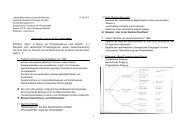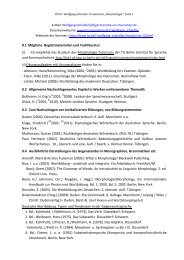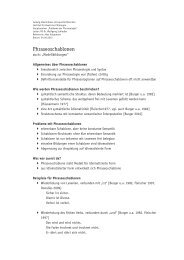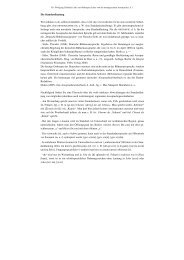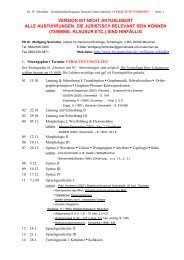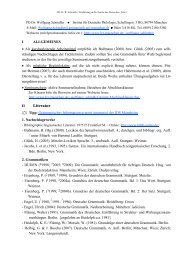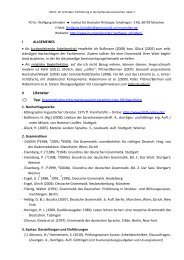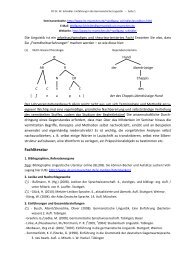Chapter 18 Lexical Functions: Description of Lexical Relations in a ...
Chapter 18 Lexical Functions: Description of Lexical Relations in a ...
Chapter 18 Lexical Functions: Description of Lexical Relations in a ...
Create successful ePaper yourself
Turn your PDF publications into a flip-book with our unique Google optimized e-Paper software.
—<strong>Chapter</strong> <strong>18</strong>. <strong>Lexical</strong> <strong>Functions</strong>— 41<br />
22. Equip [Fr. équipage (crew)] = (the staff/the crew <strong>of</strong> …)<br />
Examples<br />
Equip(university) = staff [<strong>of</strong> ART ~];<br />
faculty [<strong>of</strong> ART ~]<br />
Equip(theater) = company [<strong>of</strong> ART ~]<br />
Equip(aircraft) = crew [<strong>of</strong> ART ~]<br />
Equip(hospital) = personnel, staff<br />
[<strong>of</strong> ART ~]<br />
Equip(empire) = population, subjects<br />
[<strong>of</strong> ART ~]<br />
Equip(catholic church) = clergy [<strong>of</strong> ART ~]<br />
Cap and Equip both have mostly non-fused elements <strong>of</strong> the value—L can be added to L´<br />
almost everywhere, as we see <strong>in</strong> the above examples; as a rule, L´ forms with L a collocation.<br />
Nonetheless, Cap and Equip determ<strong>in</strong>e particular names (‘What do you call the head <strong>of</strong> L?’,<br />
‘What do you call the personnel <strong>of</strong> L?’), and thus both are paradigmatic LFs.<br />
LFs 23 and 24 correspond to syntactic <strong>in</strong>flectional mean<strong>in</strong>gs: those <strong>of</strong> the participle and<br />
<strong>of</strong> the deverbal adverb, respectively. Both are applicable to LUs whose mean<strong>in</strong>gs are functors and<br />
have actants.<br />
23. A i = actantial adjectives<br />
The LF A i denotes the determ<strong>in</strong><strong>in</strong>g property <strong>of</strong> the i-th Deep-SyntA <strong>of</strong> L [= DSyntAi(L)]<br />
from the viewpo<strong>in</strong>t <strong>of</strong> its role <strong>in</strong> the situation (L). Semantically, A 1 is roughly equivalent to an<br />
active participle (≈ (which is L-<strong>in</strong>g)), and A 2, to a passive participle (≈ (which is be<strong>in</strong>g L-ed)).<br />
Syntactically, A i is an adjective; it is prototypically used, as is expected <strong>of</strong> a Deep Adjective, to<br />
modify a noun.<br />
Examples<br />
A 1(angerN) = <strong>in</strong> [~] //angry<br />
A 1(importance) = <strong>of</strong> [~] //important<br />
A 1(knowV) = //aware<br />
A 1 (searchV[for NY]) = //<strong>in</strong> searchN [<strong>of</strong> NY]<br />
24. Adv i= actantial adverbs<br />
A 2(fireV [upon NY]) = //under fire<br />
A 2(conduct [an orchestra]) = //under the baton [<strong>of</strong> NX]<br />
A 2(crossfire) = caught [<strong>in</strong> ~]<br />
A 2(analyze) = //under analysis<br />
The LF Adv i denotes the determ<strong>in</strong><strong>in</strong>g property <strong>of</strong> the action by the i-th DSyntA <strong>of</strong> L<br />
accord<strong>in</strong>g to the role <strong>of</strong> the DSyntAi(L) <strong>in</strong> the situation described by L. Semantically, Adv 1 is<br />
roughly equivalent to an active deverbal adverb (≈ (while L-<strong>in</strong>g)), and Adv 2, to a passive deverbal<br />
adverb (≈ (while be<strong>in</strong>g L-ed)). Syntactically, Adv i is a Deep adverb; it is prototypically used to<br />
modify a verb, an adjective or another adverb.


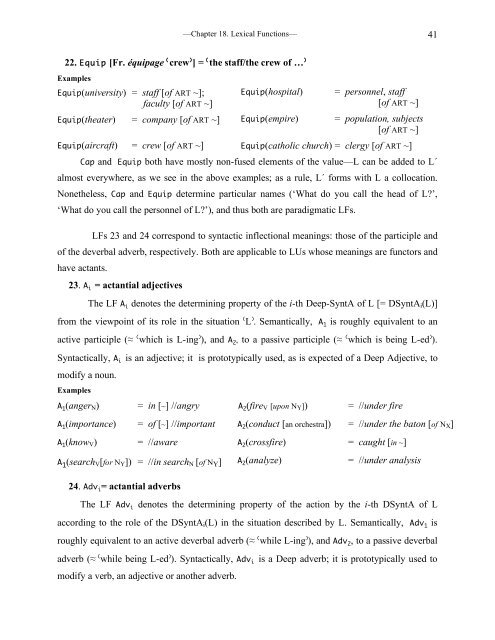
![E-Mail: Wolfgang.Schindler[ätt]germanistik.uni-muenchen.de Web ...](https://img.yumpu.com/51590147/1/184x260/e-mail-wolfgangschindlerattgermanistikuni-muenchende-web-.jpg?quality=85)
